 |
 |
This topic details the options for setting up infrastructure within a Remote Desktop Services (formerly Terminal Services) environment in order to use IRIS.
Recommendations are given for various configurations and settings. Other choices may work without issue, however these are the settings used when testing the products internally.
If you encounter an issue with IRIS that appears to be related to using different settings, support may request that you change settings to match our recommendations to verify the issue still exists before proceeding with standard troubleshooting.
Click the links below to jump to a particular section:
Configuration of Remote Desktop Session Host server Settings
Remote Desktop and Remote Apps
There are several components to make available in the infrastructure for using IRIS:
SQL Database – requires SQL Server. Recommend a full edition of SQL Server (for example, for SQL Server 2012: Standard, Business Intelligence or Enterprise edition; Express edition is only recommended for up to six IRIS users due to limits on RAM usage and Database size, please refer to the current IRIS system requirements and Limitations of SQL Server Express).
These components can be spread across one or more physical (or virtual) servers and some common setups are as follows:
Single Server – SQL Server; IRIS Server, Terminal Server Figure 1 - Sever Option 1
Two Servers (1) Figure 2 - Server Option 2:
IRIS Server; Terminal Server
The following table shows the recommended maximum numbers of users for each setup. Note that the actual maximum depends on the hardware specification of each server, network performance, other applications which are delivered over RDS and other external environmental factors.
Provisioning virtual servers allows you to scale up the hardware specification without much downtime and keeping the Terminal Server(s) separate allows you to add more Terminal Servers to balance the load and improve performance if necessary.
| Server Options | Recommended Max Number of End Users |
| Option 1 | 5-10 |
| Option 2 | 20-30 per terminal server |
Please note that if using SQL Server Express edition, the maximum utilized memory is 1GB and the maximum computing capacity is 1 physical CPU or 4 cores (which may slow down performance for systems with more than the recommended number of users – currently 6). Maximum database size is limited to 10 GB per database in SQL Server 2008 R2 & SQL Server 2012 (4 GB for SQL Server Express 2008 and earlier).
The amount of resource usage, notably RAM usage can vary hugely depending on the task(s) in hand by each user (and what other services are running on that server (for example, SQL Server, Exchange and so on).
A remote desktop session may present the user with many applications (including IRIS) and each has its own memory requirements. Therefore, it is difficult to recommend how much RAM each Terminal Server should have. In general, we would recommend between 250-500Mb of free RAM per concurrent user of IRIS on a Terminal Server.
However, a heavy user may use much more (for example, with Accounts Production, Business Tax and Personal Tax all open at once [perhaps multiple copies of each] in addition to the main menu, Practice Management and their time sheet). We recommend that you monitor Physical RAM usage through peak periods and make adjustments to resources or user number as necessary.
Once again, with a virtual server set up, resources can be increased with minimal downtime. Adding Terminal Server(s) to a farm can also help spread resources more efficiently and balance the load of the user population.
The example environments are shown in the following system diagrams:
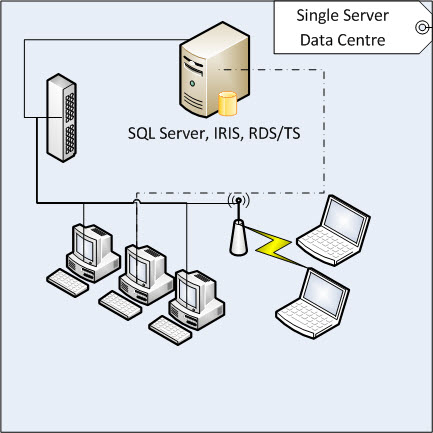
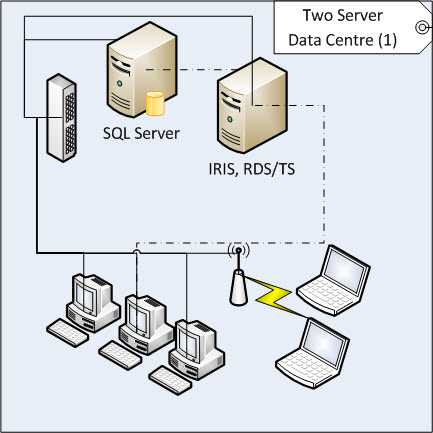
Prior to any install, it is good practice to reboot the server and prevent any logins that may disrupt the installation procedure. All installations should be carried out by a domain or local Administrator. This topic does not cover any generic access concepts (such as firewall access), but suffice it to say, any dotted line in the system diagrams above indicates access that must be permitted (for example, IRIS Server must be able to access the SQL Server and have appropriate credentials and so on).
Installation on the SQL Server is typically one off (although Service Packs may be added at a later time).
Install SQL Server
Configure an instance for IRIS
IRIS MUST be installed (and upgraded) on the Terminal Server unless Multiple Terminal Servers are in use, in which case the IRIS Programs folder needs to be installed onto each terminal server. For details on installing the IRIS Programs on to a terminal server, click here.
The user performing the installation of IRIS must hold the sysadmin role in the SQL Server Instance being used for IRIS.
Initial Installation
Each upgrade
It is necessary for ALL Terminal servers to share a single data & Format folder. To edit the destination paths share the IRIS install directory on the server where the DATA folder is stored (and all sub folders and files) to all IRIS users with R&W permissions. For example, create a share of the form //irisserver01/iris/
Once you have this path please open MAKETTL
and edit the paths so they are set to the shared location:
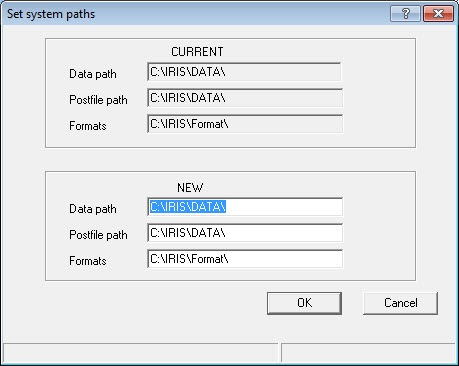
All configuration settings specified below are those recommended by IRIS. This topic does not discuss brokered connections using RD Connection Broker for a load-balanced RD Session Host server farm, although there is no reason why this connection approach should not be used. Most of these settings can be set using Group Policies, which is best practice.
Screenshots and descriptions given below show the interactive methods. Please refer to Microsoft documentation for more information on each of these settings and how to apply by Group Policy. Settings described assume the appropriate Server Role is installed and specific examples use Windows Server 2008 R2. Other versions will have similar settings although they may be accessed in a different way. Please refer to the Microsoft documentation for your platform for further guidance.
Any settings changed will only apply to newly created sessions, not those already active.
Settings which impact IRIS are as follows; Screenshots are referenced:
On the Terminal Server, run Remote Desktop Session Host Configuration and edit the Properties of the RDP-Tcp (or equivalent) connection.
Sessions tab - Figure 6 – RDP Properties - Remote Desktop Session Host settings
This tab will override any user settings for the behaviour of the RDP session timeouts and overriding is recommended. When a user session is forcibly terminated, it can leave a login active on the IRIS Database (as IRIS was not closed down properly). Entering anything different to Never for any of the timeouts (for example, no timeout), causes sessions to be forcibly terminated.
The same is true if End session is chosen for When session limit is reached or connection in broken. These orphaned logins contribute towards licence limits so should be avoided if possible by choosing settings as shown in the screenshot. See Licence usage for more information.
Client Settings tab - Figure 7 - RDP Properties - Client Settings
For the best visual experience of IRIS, select 32-bit Colour Depth. Disabling Audio & video playback will not impact the core IRIS applications, but may prevent correct playback of any videos available through online help or the IRIS OpenPortal and is therefore not recommended.
Again in Remote Desktop Session Host Configuration edit the Properties of one of the General settings. Recommended settings are only on the General tab Figure 8 - RD Session settings.
Treatment of temporary folders – IRIS creates an error log in the TEMP directory which should be retrieved if needed before logging out. Otherwise, the content of the TEMP directory is not needed between sessions so you can safely tick Delete temporary folders on exit (however having it unticked will not affect performance but may use more disk space).
If a user is permitted to connect more than one session, Use temporary folders per session must be ticked to prevent temporary files from one session clashing with temporary files from another session.
Ticking Restrict each user to a single session will prevent users starting multiple sessions and using multiple IRIS licences.
Under User logon mode, Allow all connections is the default setting. However, when preparing for a maintenance window, you may choose Allow reconnections, but prevent new logons until the server is restarted. This will enable you to stop new connections prior to a restart of the server.
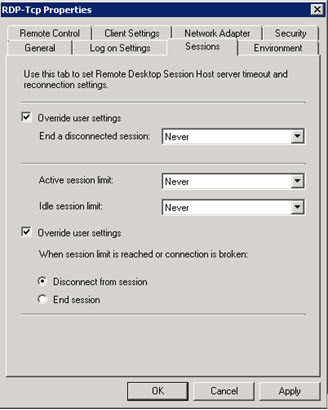
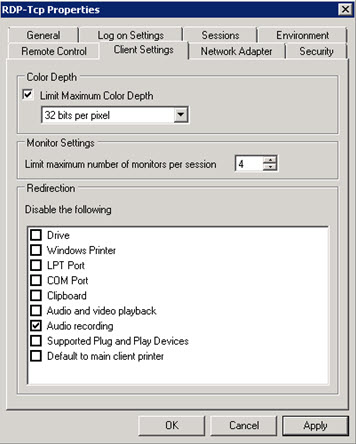
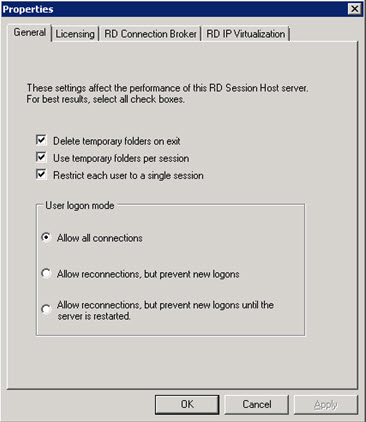
You can use IRIS over a Remote Desktop session with no further configuration (client access requires a suitable RDP client such as Remote Desktop Connection which is part of most recent versions of windows Figure 9 - Remote Desktop Connection). For the best visual experience, 32-bit colour depth is required, Figure 10 - RDC - Colour Depth Setting (see Known Issues)
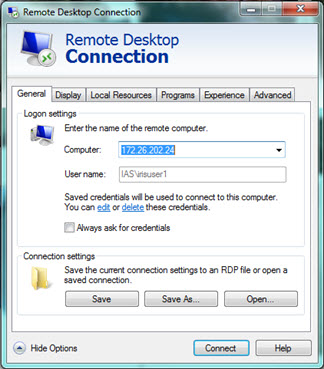
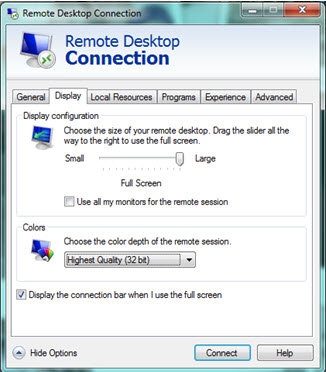
Alternatively, IRIS can be deployed as a RemoteApp.
On the Terminal Server, use the Remote App Manager snap-in to launch the RemoteApp Wizard with the Add RemoteApp Programs Action. Simply select the IRIS Main Menu (and other programs if you wish) to enable them for RemoteApp, Figure 11 - The RemoteApp Wizard.
There are very few settings for the Remote App but you may wish to use the Properties button to change the Alias of the shortcut and the Icon to be used (sometimes Windows tries to use the icon of the shortcut on the Terminal Server desktop, which is not visible to the end user – select the actual IRIS program for example, iwinload.exe from the shared folder, for example, \\irisserver\iris\iwinload.exe
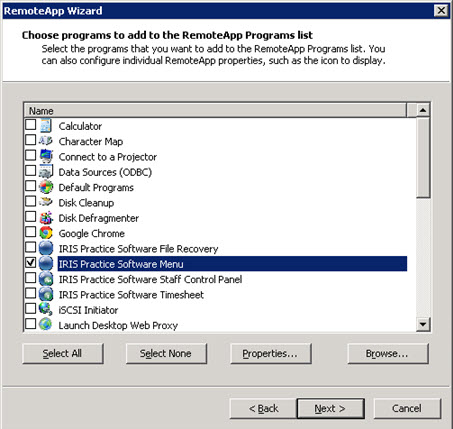
Once set up, use the RDP Settings Change link in the RemoteApp Manager to check that 32-bit Colour Depth is selected in the User experience section, Common RDP Settings tab of the RemoteApp Deployment Settings window, Figure 12 - Remote App Deployment Settings, (see Known Issues)
You can then select distribution options: RD Web Access can be used, or you can create an .RDP file or an installer package to distribute to users. The latter two will create a shortcut to the RemoteApp on the client machine, while the former will allow launching Apps through a web portal.
Further advice for configuring Remote Desktop Services, RemoteApps, RD Web Access or other distribution methods is not available from IRIS.
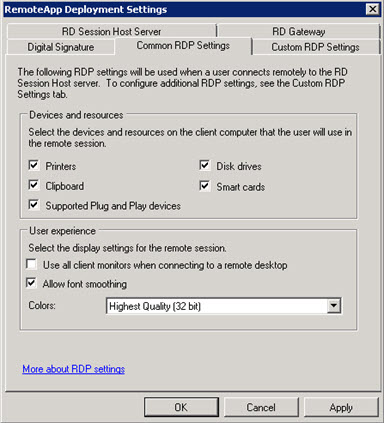
Although no different to a non RDS environment, it is important to understand the impact of certain actions on user licences in IRIS. When a user launches and IRIS application (Accounts Production, Business Tax and so on), they start a session which effectively takes a user licence for that application. That session remains active, taking up a user licence until such time that the application is closed by the user.
There are several scenarios which may cause that session to remain active in the database, even though the user is not using the IRIS application:
Application crash
RDS/TS Session reset by timeout
RDS/TS Session reset by Administrator
Forcibly ending a process from task manager or task bar
Over time, these licences and locks can build up, meaning that you may hit your user licence limit sooner than expected. If this happens, you should selectively clear these orphaned logins and locks using System Maintenance (System | Logins and System | Locks).
The sessions are cleared automatically once all users have existed IRIS applications and the first user logs back in. This can be achieved by company policy (ensuring all users properly log out at the end of the day). Alternatively, this can be achieved by ending all RDS Sessions overnight or rebooting the Terminal Server(s).
There are some known issues that are specific to the environment when running under Remote Desktop Services. None affect the business function of the software and are more cosmetic in nature.
They are detailed below:
Environment: RemoteApp
Summary: Business Tax - Autopilot screen appears behind others giving the impression the application has hung.
Detail: When selecting Business Tax -> Data Entry -> AutoPilot, depending on screen resolution and the size of the Business Tax Application window, when the user presses OK on the Enhanced Expenditure screen, the next screen (Claims for Capital Allowances) can appear ‘behind’ the main application window, giving the impression that the application has hung. In some cases, only part of the window will be visible.
Workarounds:
Use Business Tax maximised. When the main application window is maximised, the problem does not appear to occur.
Click another application icon on the Windows taskbar then switch back to Business tax. In most cases, the current screen will draw on top and you can continue the Autopilot.
On the keyboard, press OK (to continue) or ESC (to quit the Autopilot) – even if the buttons or the whole screen are not visible (as long as Business Tax has focus).
Use individual data entry screens from the Data Entry menu.
Environment: RemoteApp/Remote Desktop
Summary: Accounts Production – Tag editor or iXBRL Editor screens can appear behind others or take a long time to load giving the impression the application has hung.
Detail: When selecting Accounts Production | Reports | iXBRL and CH E-File or Administration iXBRL Editor and CH E-File, the resultant Tag Editor/iXBRL Editor can take longer than usual to appear giving the impression that the application has hung or crashed. In some cases, the window can appear behind others or flicker as it is drawn.
Workaround: Simply select or
reselect the Tag/iXBRL Editor icon on the Windows taskbar to bring focus
to the Tag/iXBRL Editor  .
.
Environment: RemoteApp/Remote Desktop
Summary: Accounts Production, CoSec & Personal Tax – Toolbar icons appear with a black background
Detail: When using a colour depth lower than 32-bit on the RD Session settings, the icons on the toolbars of some applications can appear with a black background, rather than transparent/grey (see screenshots below).


Workaround: Select 32-bit colour depth in the appropriate settings – See sections above for further details: RD Session Host Server Settings for Remote Desktop and for RemoteApp.